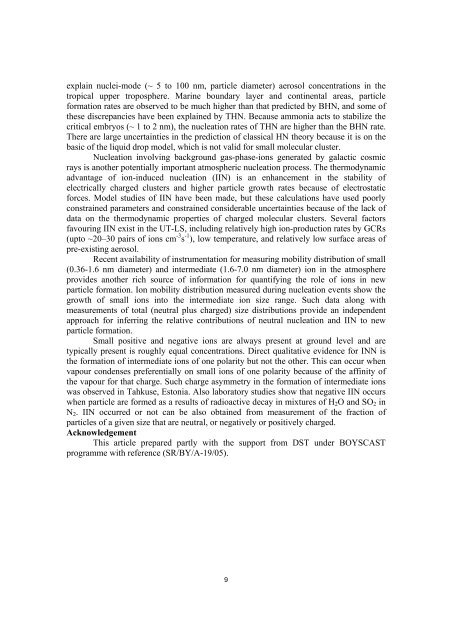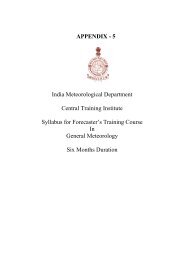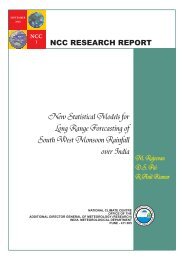BULLETIN OF IMSP - (IMD), Pune
BULLETIN OF IMSP - (IMD), Pune
BULLETIN OF IMSP - (IMD), Pune
- No tags were found...
You also want an ePaper? Increase the reach of your titles
YUMPU automatically turns print PDFs into web optimized ePapers that Google loves.
explain nuclei-mode (~ 5 to 100 nm, particle diameter) aerosol concentrations in thetropical upper troposphere. Marine boundary layer and continental areas, particleformation rates are observed to be much higher than that predicted by BHN, and some ofthese discrepancies have been explained by THN. Because ammonia acts to stabilize thecritical embryos (~ 1 to 2 nm), the nucleation rates of THN are higher than the BHN rate.There are large uncertainties in the prediction of classical HN theory because it is on thebasic of the liquid drop model, which is not valid for small molecular cluster.Nucleation involving background gas-phase-ions generated by galactic cosmicrays is another potentially important atmospheric nucleation process. The thermodynamicadvantage of ion-induced nucleation (IIN) is an enhancement in the stability ofelectrically charged clusters and higher particle growth rates because of electrostaticforces. Model studies of IIN have been made, but these calculations have used poorlyconstrained parameters and constrained considerable uncertainties because of the lack ofdata on the thermodynamic properties of charged molecular clusters. Several factorsfavouring IIN exist in the UT-LS, including relatively high ion-production rates by GCRs(upto ~20–30 pairs of ions cm -3 s -1 ), low temperature, and relatively low surface areas ofpre-existing aerosol.Recent availability of instrumentation for measuring mobility distribution of small(0.36-1.6 nm diameter) and intermediate (1.6-7.0 nm diameter) ion in the atmosphereprovides another rich source of information for quantifying the role of ions in newparticle formation. Ion mobility distribution measured during nucleation events show thegrowth of small ions into the intermediate ion size range. Such data along withmeasurements of total (neutral plus charged) size distributions provide an independentapproach for inferring the relative contributions of neutral nucleation and IIN to newparticle formation.Small positive and negative ions are always present at ground level and aretypically present is roughly equal concentrations. Direct qualitative evidence for INN isthe formation of intermediate ions of one polarity but not the other. This can occur whenvapour condenses preferentially on small ions of one polarity because of the affinity ofthe vapour for that charge. Such charge asymmetry in the formation of intermediate ionswas observed in Tahkuse, Estonia. Also laboratory studies show that negative IIN occurswhen particle are formed as a results of radioactive decay in mixtures of H 2 O and SO 2 inN 2 . IIN occurred or not can be also obtained from measurement of the fraction ofparticles of a given size that are neutral, or negatively or positively charged.AcknowledgementThis article prepared partly with the support from DST under BOYSCASTprogramme with reference (SR/BY/A-19/05).9
















